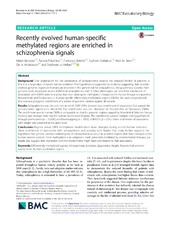| dc.contributor.author | Banerjee, Niladri | en_US |
| dc.contributor.author | Polushina, Tatiana | en_US |
| dc.contributor.author | Bettella, Francesco | en_US |
| dc.contributor.author | Giddaluru, Sudheer | en_US |
| dc.contributor.author | Steen, Vidar Martin | en_US |
| dc.contributor.author | Andreassen, Ole Andreas | en_US |
| dc.contributor.author | Le Hellard, Stephanie | en_US |
| dc.date.accessioned | 2018-10-18T08:00:22Z | |
| dc.date.available | 2018-10-18T08:00:22Z | |
| dc.date.issued | 2018 | |
| dc.identifier.issn | 1471-2148 | |
| dc.identifier.uri | https://hdl.handle.net/1956/18647 | |
| dc.description.abstract | Background: One explanation for the persistence of schizophrenia despite the reduced fertility of patients is that it is a by-product of recent human evolution. This hypothesis is supported by evidence suggesting that recentlyevolved genomic regions in humans are involved in the genetic risk for schizophrenia. Using summary statistics from genome-wide association studies (GWAS) of schizophrenia and 11 other phenotypes, we tested for enrichment of association with GWAS traits in regions that have undergone methylation changes in the human lineage compared to Neanderthals and Denisovans, i.e. human-specific differentially methylated regions (DMRs). We used analytical tools that evaluate polygenic enrichment of a subset of genomic variants against all variants. Results: Schizophrenia was the only trait in which DMR SNPs showed clear enrichment of association that passed the genome-wide significance threshold. The enrichment was not observed for Neanderthal or Denisovan DMRs. The enrichment seen in human DMRs is comparable to that for genomic regions tagged by Neanderthal Selective Sweep markers, and stronger than that for Human Accelerated Regions. The enrichment survives multiple testing performed through permutation (n = 10,000) and bootstrapping (n = 5000) in INRICH (p < 0.01). Some enrichment of association with height was observed at the gene level. Conclusions: Regions where DNA methylation modifications have changed during recent human evolution show enrichment of association with schizophrenia and possibly with height. Our study further supports the hypothesis that genetic variants conferring risk of schizophrenia co-occur in genomic regions that have changed as the human species evolved. Since methylation is an epigenetic mark, potentially mediated by environmental changes, our results also suggest that interaction with the environment might have contributed to that association. | en_US |
| dc.language.iso | eng | eng |
| dc.publisher | BioMed Central | eng |
| dc.relation.ispartof | <a href="http://hdl.handle.net/1956/18648" target="blank"> An evolutionary epigenetics approach to schizophrenia</a> | |
| dc.rights | Attribution CC BY | eng |
| dc.rights.uri | http://creativecommons.org/licenses/by/4.0/ | eng |
| dc.subject | Differentially methylated regions | eng |
| dc.subject | Schizophrenia | eng |
| dc.subject | Evolution | eng |
| dc.subject | Epigenetics | eng |
| dc.subject | Height | eng |
| dc.subject | Neanderthal selective sweep score | eng |
| dc.subject | Human accelerated regions | eng |
| dc.title | Recently evolved human-specific methylated regions are enriched in schizophrenia signals | en_US |
| dc.type | Peer reviewed | |
| dc.type | Journal article | |
| dc.description.version | publishedVersion | en_US |
| dc.rights.holder | Copyright 2018 The Authors | |
| dc.source.articlenumber | 63 | |
| dc.identifier.doi | https://doi.org/10.1186/s12862-018-1177-2 | |
| dc.identifier.cristin | 1589964 | |
| dc.source.journal | BMC Evolutionary Biology | |
| dc.source.40 | 18 | |

